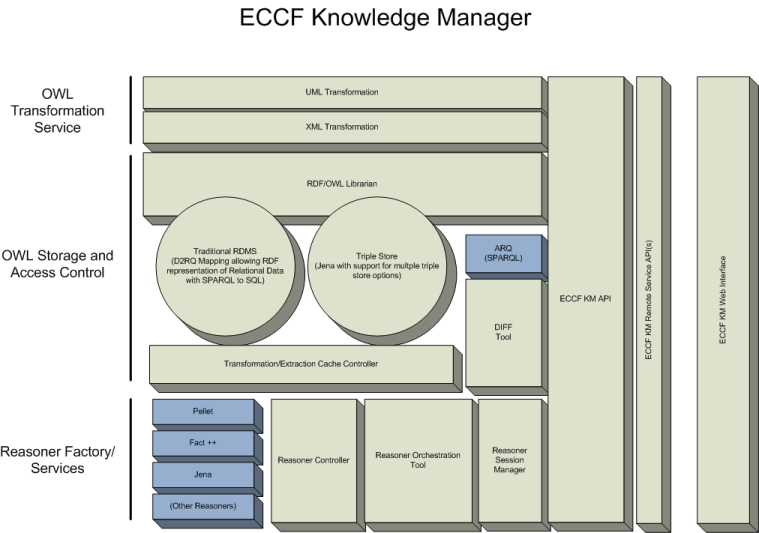This section provides an overview of the key tools that are expected to address the Semantic Infrastructure requirements. Tools are a combination of applications, user interfaces and services that address a specific Semantic Infrastructure requirement. The tool description explains how users may work with the tools to perform specific tasks.
This section includes the following:
The ECCF Registry User Interface will provide a single interface for access to all the artifacts and service metadata. Through the interface, users will be able to perform the activities identified below.
Plug-ins and development tools are extensions to existing tools to support better integration with the ECCF registry:
The Forms Editor is an end user tool for creating and editing forms:
The Conformance Testing Framework is a tool for developing automated test scripts that can be executed against an artifact or service:
Knowledge based systems support tools are knowledge engineering tools to support reasoning and inference use cases:
The following diagram illustrates a set of applications for ECCF-based knowledge management.

Legend for Diagram of ECCF Knowledge Manager
Components for Development (Category) | Description |
|---|---|
Box name:UML Transformation (OWL Transformation Service) | The UML transformation process takes a standard UML representation (XMI) of a model and performs analysis to determine semantics and definitions. |
Box name:XML Transformation (OWL Transformation Service) | The XML transformation process takes XML Schemas and XML instances to generate and determine semantics and definitions. |
Box name:RDF/OWL Librarian (OWL Storage and Access Control) | The librarian is responsible for knowing what definitions are represented in the registry. In addition, the librarian is responsible for versioning and representation of the governance process. |
Box name:Transformation/Extraction Cache Controller (OWL Storage and Access Control) | The cache controller is used to improve performance and interactions of the various components. Since reasoning systems may require the merging of large amounts of knowledge, the controller will prevent unnecessary fetching operations. |
Box name:DIFF Tool (OWL Storage and Access Control) | The DIFF tool provides a number of functional behaviors such as determining differences between two versions of semantic representations. In addition, the diff tool looks at the semantics to determine if two systems of representations may have common areas of interest. |
Box name:Reasoner Controller (OWL Storage and Access Control) | Manages the reasoner configurations and implementations so when called upon they are properly configured. |
Box name:Reasoner Orchestration Tool (OWL Storage and Access Control) | The orchestration tool provides integration between reasoners. This allows for the staging of reasoning systems to allow for concurrent or parallel processing of reasoning systems. |
Box name:Reasoner Session Manager (OWL Storage and Access Control) | Since users may perform interaction with the reasoning systems with specific knowledge stores and reasoner configurations, the session manager maintains the state and processes until the user or system no longer requires it. |
Box name:ECCF KM API (OWL Storage and Access Control) | The set of functional APIs that can be called by applications. |
Box name:ECCF KM Remote Service API (OWL Storage and Access Control) | The set of remote service APIs that are called by applications. These service calls include appropriate implementations such as SOAP and RESTful services. |
Box name:ECCF KM Web Interface (OWL Storage and Access Control) | The Web interface is a web application through which users can interact with the Knowledge Manager. From this application users can upload knowledge sources for processing by the reasoners, download semantic representations of processed models and schemas, as well as perform direct queries against the knowledge stores. |
Box name:RDBMS Store (OWL Storage and Access Control) | This is information stored in traditional RDBMS stores with traditional schemas. Semantic access to these system will be performed using the open source tools. |
Box name:Triple Store (OWL Storage and Access Control) | The most flexible representation of semantic information is stored in a triple store. There are multiple possible physical representations including files, RDBMS triple stores, and dedicated high performance triple stores. |
Box name:Jena (OWL Storage and Access Control) | Jena is a standard open source interface tool that allows for the access of triple store information in RDF and OWL formats. Jena is a very flexible tool with the ability to interact with the stores with various reasoners. |
Box name:ARQ (SPARQL) (OWL Storage and Access Control) | ARQ is an open source implementation of the SPARQL language. SPARQL provides a standardized query language for interacting with triple stores. |
Box name:Pellet (Reasoner Factory/Services) | Pellet is an open source OWL 2 reasoner. Pellet provides standard and reasoning services for OWL ontologies. |
Box name:FaCT ++ (Reasoner Factory/Services) | FaCT++ is an open source OWL DL reasoner (partially OWL 2), is implemented in C++ and uses optimized tableaux algorithms. |
Box name\:D2RQ (Reasoner Factory/Services) | An open source tool, which works with traditional RDBMS structures and presents them using RDF semantics. This allows for SPARQL queries of RDMS data, as well as integration with reasoning systems. |
Box name:Other Reasoners (Reasoner Factory/Services) | The Jena tool provides for integrations with alternative reasonsers, which can be determined later. |